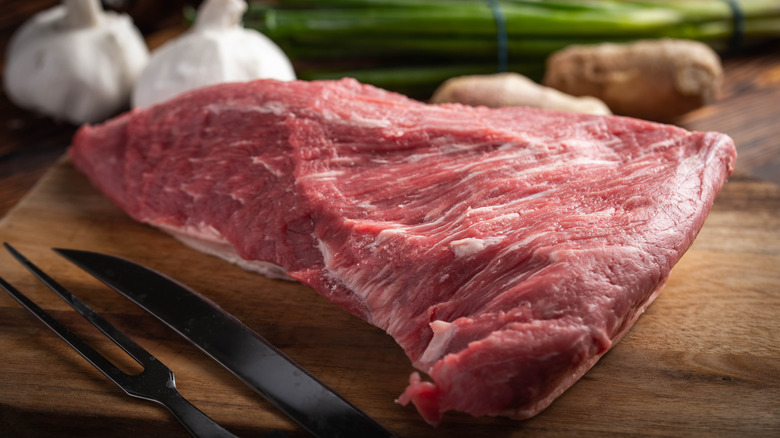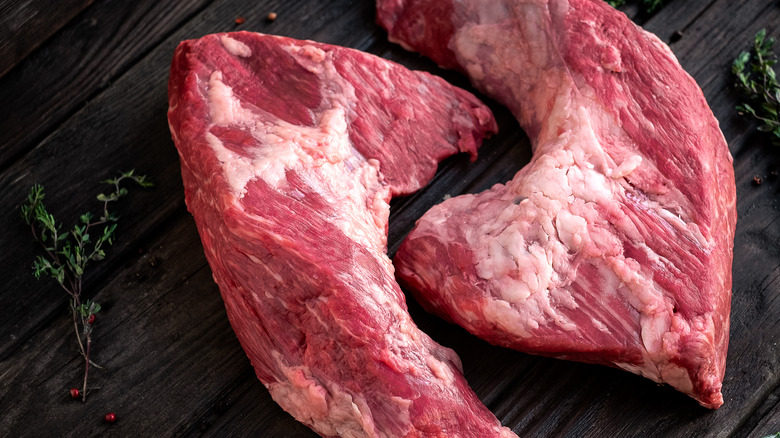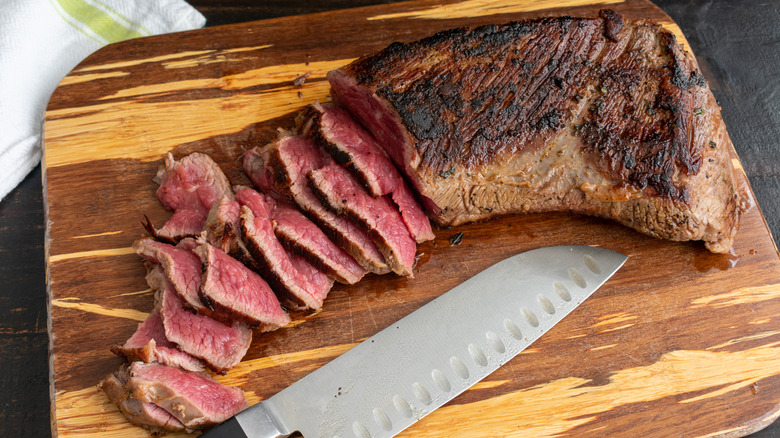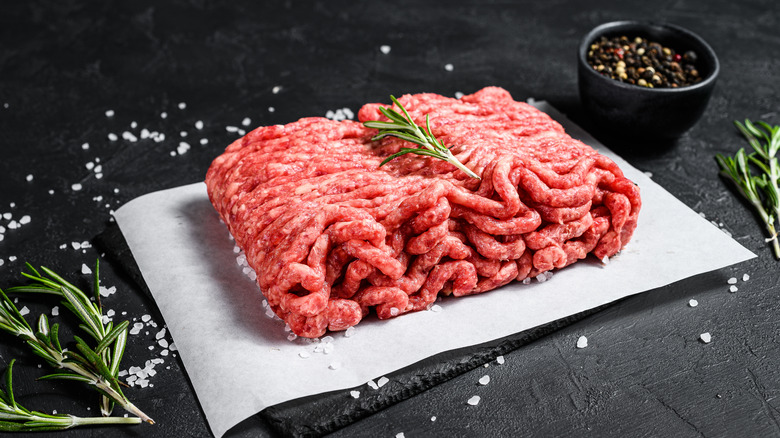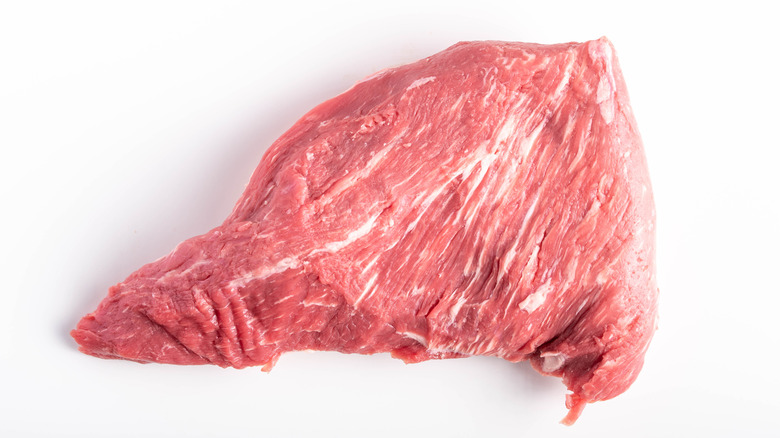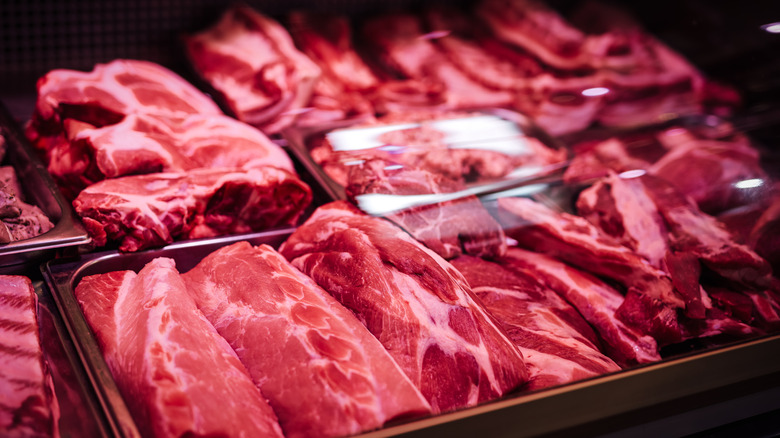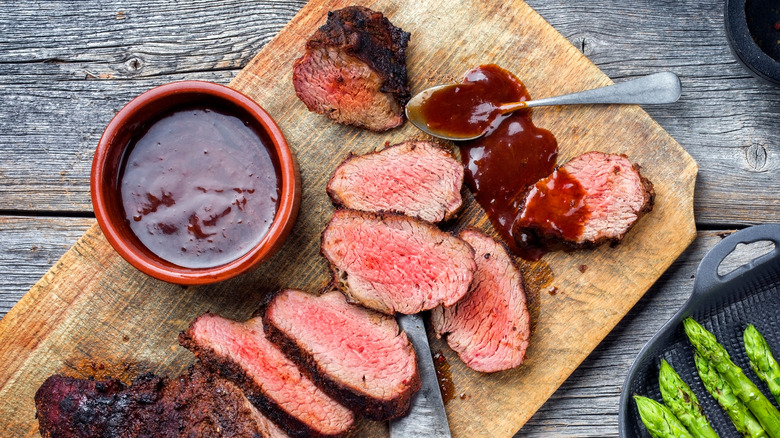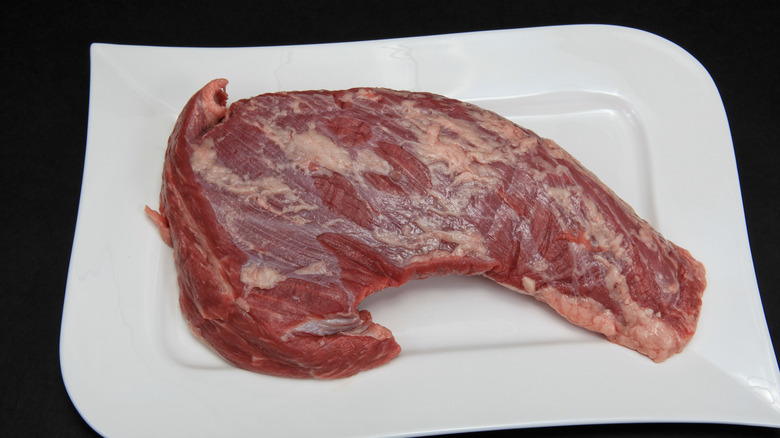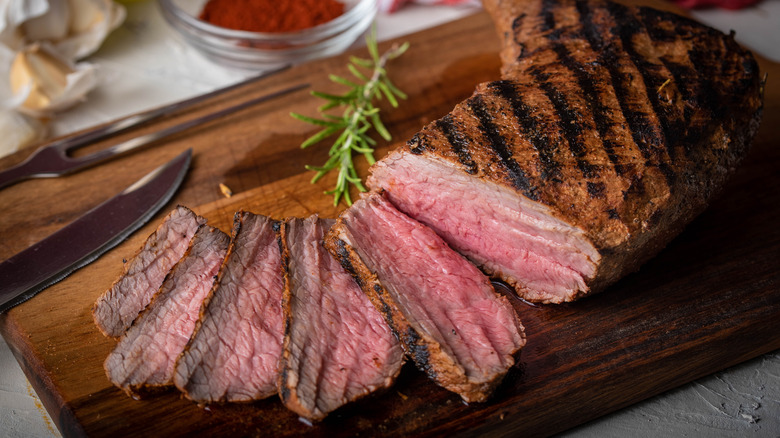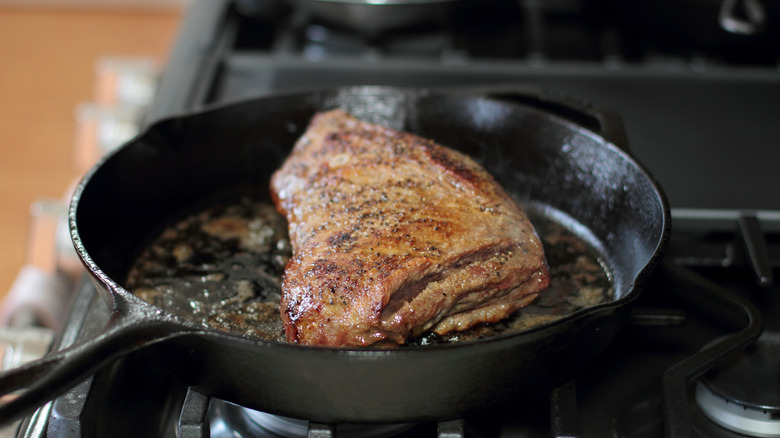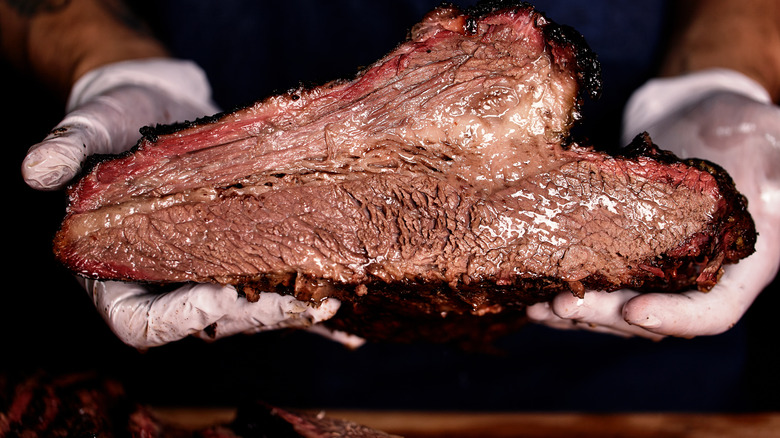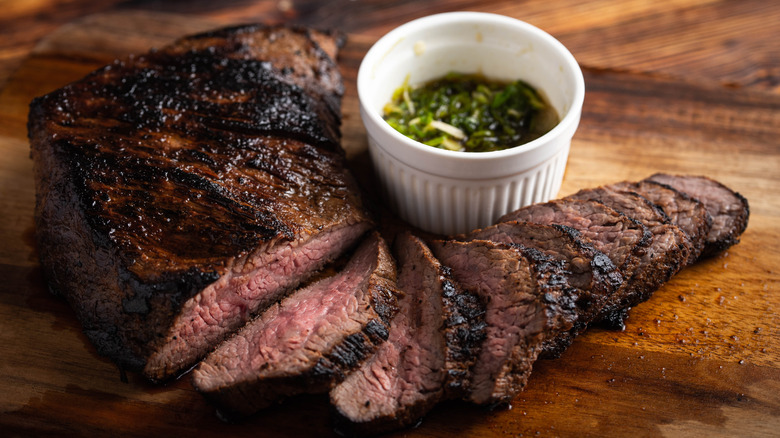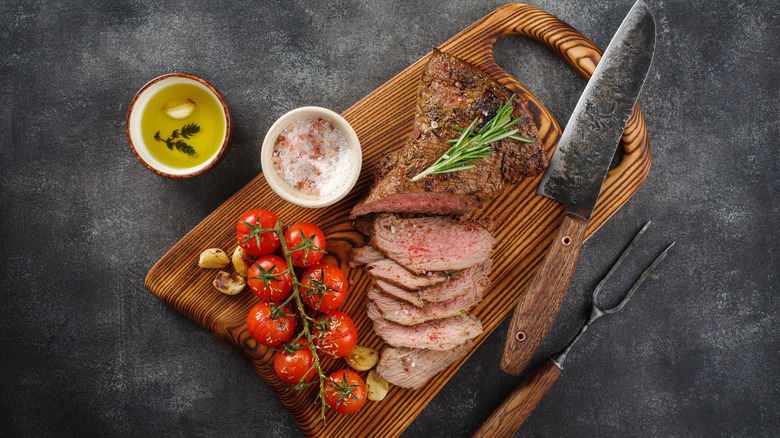The Untold Truth Of Tri-Tip Steak
Tri-tip steak certainly isn't the top choice at your average steakhouse — or even, for that matter, available at many supermarkets or butcher counters. Indeed, according to the Santa Maria Valley Chamber of Commerce, for years, butchers barely gave this oddly-shaped cut a second look, as there was just one piece per side of beef (aka two per cow). Instead of taking up prime butcher case real estate with tri-tip, butchers would instead slice or grind it for burgers or stew, the outlet asserts — thus depriving customers of the joy that this versatile cut of meat brings.
That said, times are changing. This cut is starting to become more widespread in American supermarkets and butcher shops, and frankly, it's high time we consumers gave this cut of beef a second look. With its slightly odd shape — and myriad names — tri-tip a stands out as a richly flavored cut of meat that's equally happy grilled, roasted, marinated, rubbed in spices, or even treated as a "poor man's brisket," according to Steak School by Stanbroke.
Are you ready to let this under-appreciated beef into your life? Then read on.
Tri-tip steak has an unusual shape
Tri-tip steak's name offers a hint as to one of its most noticeable traits: its shape. Indeed, tri-tip is a reference, according to The Spruce Eats, to the triangular form of this bit of beef; it is even sometimes called the triangle steak.
Steak School by Stanbroke notes that the tapered tip"of the triangle is a bit thinner than the rest, which means that it can cook a bit unevenly (this would be perfect for families where some like it rare and some like it medium). The outlet compare's tri-tip's shape to a boomerang. The cut hails, per Beef: It's What's For Dinner, from the bottom sirloin, alongside other sub-primal cuts like petite sirloin, sirloin bavette, and ball tip. According to Dead Rooster, the fact that there are only two tri-tips on the whole cow is just one of many reasons it can be hard to find.
Tri-tip steak goes by many different names
One reason it might be hard for you to find tri-tip steak at your local supermarket is that tri-tip is not the only name it goes by.
According to The Spruce Eats, tri-tip can also be found by names like culotte steak, bottom sirloin tip, or Newport steak. To these, Steak School by Stanbroke adds bottom sirloin butt and "poor man's brisket."
But its most popular nicknames, per The Spruce Eats, are California cut or Santa Maria steak. The association with Santa Maria may date back as far as the 19th century, or at least, so the Santa Maria Valley Chamber of Commerce claims. The outlet points to a local ranchero tradition of roasting sirloin — including tri-top — over a red oak fire. But the Chamber of Commerce and Stanbroke also credit the restaurant Santa Maria Market with popularizing tri-tip in the 20th century.
To hear both outlets tell it, it was Bob Schutz, then the owner of the Santa Maria Market, who in the 1950s first decided to prepare and eat tri-tip, not ground into burger meat, but as a steak — covered liberally, according to A Food Lover's Kitchen, with a simple yet delicious rub of salt, pepper, and garlic powder. Locals have been digging in ever since.
Tri-tip steak was ground into burger meat
Another reason that tri-tip may be tough to find is that it's often hiding right under your nose in ground beef. Indeed, according to Steak School by Stanbroke, tri-tip was almost exclusively sold as ground beef until its rise in popularity in the 1950s.
Using tri-tip for ground beef wasn't just a way for butchers to hide it in plain sight. It's also a good way of using up a cut that can be tricky to cook. Per Stanbroke, tri-tip steak boasts a rich, meaty flavor, but due to its grain patterns, one of which runs vertical and the other horizontal, it can end up eating tough and chewy. (Of course, there are ways to remedy that aside from just grinding it up, which we'll explore later). One thing is for sure: it's much easier to cook tri-tip correctly in ground beef form than it is to make a whole tri-tip tender and juicy on the grill.
Tri-tip steak used to be much harder to find
Tri-tip has historically been pretty tough to find the further East you go. On Smoking Meat Forums, a Pennsylvania resident noted that butchers seemed puzzled when she even asked for it. Posters on one Reddit thread from 2016 speculated that tri-tips, being more popular in the West, might simply be shipped westward by East Coast butchers. While no one confirmed the theory, according to Dead Rooster's Mark Holzkopf, a professional butcher, as an apprentice meat cutter, he didn't even know what this cut was, so it doesn't seem too farfetched to assume that some butchers passed over it entirely.
That said, tri-tip appears to be growing in popularity these days, with many Redditors on the thread reporting that they were beginning to find it in their local, non-Californian supermarkets — something that may have to do with everyone from author Mark Bittman to Chef David Guas extolling its many virtues.
Tri-tip steak is not too expensive
When you do track down a tri-tip, rest assured: you won't have to shell out too much cash for it. In fact, according to The Spruce Eats, it is far less costly than cuts like a ribeye while somehow managing to be just as flavorful. Indeed, David Guas, chef/owner at Bayou Bakery in Washington, DC, tells Thrillist that tri-tip is the most underrated steak out there.
"It is probably the least-expensive, best taste of beef you can purchase," he tells the outlet.
According to Foodly, Costco's Steakhouse Tri-Tip — which is pre-seasoned and marinated — clocks in at just $5.99 a pound. Steak School by Stanbroke notes that you can get it even more cheaply untrimmed, though you'll need to use a sharp knife — and a bit of technique — to remove the excess fat and sinew from the outside. The outlet notes that if you opt for this route, you should remove any ragged ends and silverskin and trim down as many large chunks of fat as possible.
Tri-tip steak is well-marbled and flavorful
If chefs love tri-tip so much, it's in large part thanks to its beautiful marbling, which lends this cut a deep, rich, beefy flavor.
"There's not a lot of connective tissue, so it cooks very quickly and easily," says David Guas, chef/owner at Bayou Bakery in Washington, DC, tells Thrillist of the steak; The Spruce Eats applauds its ideal marriage of beefy intensity with buttery richness.
Taste of Home notes that tri-tip — much like sirloin — is lean and devoid of the fat cap ribeye and New York strip are known for; the intramuscular fat is where it's at in this cut. That said, in some cases, notes The Food Charlatan, you can get an untrimmed tri-tip with the layer of fat intact, which makes it even more luscious than leaner versions of this cut. Whether you opt for trimmed or untrimmed all depends on how you plan to cook it.
Tri-tip steak can be bought as a steak or a roast
According to Steak School by Stanbroke, the tri-tip can be purchased both in steak form or in roast form; the roast is great for a crowd, while the steak is good for a person or two. The difference, per Butcher Box, is simple: While both hail from the same cut, the steaks are individually sliced from the roast. But while they are, at their core, the same thing, there are a few differences to bear in mind, notably when it comes to cooking method.
According to Beef: It's What's For Dinner, tri-tip roast is better for indirect grilling, smoking, sous-vide cooking, or oven-roasting. The steak, meanwhile, is happier cooked in a skillet or stir-fried. Both, the outlet notes, can be broiled or grilled, and since it's the latter method that gained this steak its fame, it's definitely worth a closer look.
Tri-tip steak is at its happiest when grilled
You can cook it many ways, but there's a reason that tri-tip steak is a classic on the grill. It's no coincidence that it rose to acclaim at the annual Santa Maria barbecue festival, according to The Spruce Eats. Both that outlet and Taste of Home agree that it's the ideal cut for grilling. There's just something about the char and smokiness of a grill that complements tri-tip's beefy flavor perfectly.
David Guas, chef/owner at Bayou Bakery in Washington, DC, tells Thrillist that tri-tip is his "go-to meat for grilling." "It has a way of soaking in the wonderful flavors and allowed a slight caramelization on the outside," he adds.
Butcher Mark Holzkopf writes for Dead Rooster that tri-tip steak is wonderful when seasoned with dry rub and seared over direct heat before being grilled over indirect heat and then rested — an essential part of the puzzle. According to Grillseeker, tri-tip can be more likely than many other cuts to be tight post-sear. The outlet recommends at least a 10-minute rest — if not 15 minutes — to ensure that it's nice and tender before you slice it.
Tri-tip steak can also be oven-roasted
If you're not lucky enough to have easy access to an outdoor grill, tri-tip steak is also very happy oven-roasted.
According to A Food Lover's Kitchen, tri-tip needs to be cooked quickly and at a higher heat than many other roasts in order to ensure that it emerges medium rare and tender. About ten minutes per pound at 450 Fahrenheit, the outlet says, is the perfect amount of time for a juicy, flavorful final result. As always it's best to rely on a probe thermometer to assess the interior temperature for the perfect, juicy slice. Steak School by Stanbroke asserts, meanwhile, that a low-and-slow method can also provide luscious results, so clearly there's more than one way to achieve a delicious tri-tip.
Either way, a word of warning from tri-tip aficionado The Food Charlatan: While the fat cap should be removed from the tri-tip when grilling it, it's best to leave it on when oven roasting to ensure that it stays juicy. Cooking the roast fat-side up ensures that the fat keeps the meat nice and moist.
Tri-tip can be cooked like brisket
What do you get when you cook a tri-tip like a brisket? According to Or Whatever You Do, it's a "trisket."
On a more serious note, tri-tip does make a great stand-in for brisket, despite the two cuts actually being very different. Brisket hails from the breast area of the cow, according to McCormick, while tri-tip comes from the sirloin, according to Santa Maria Valley. And while brisket contains a lot of connective tissue, tri-tip does not (via Thrillist). But despite these differences, Hey Grill Hey notes that low, slow smoking is just as tasty an approach for tri-tip as it is for brisket.
That said, since tri-tip is leaner than brisket, you need all the help you can get in keeping it moist. Leave the fat cap on the tri-tip, and be sure to wrap it well before the second smoke. 4 to 5 hours unwrapped at 225 Fahrenheit followed by another 3 or 4 hours wrapped should help it reach that coveted 200-degree internal temp with all of its moisture intact.
Tri-tip is even more delicious marinated
According to The Spruce Eats, while tri-tip is very flavorful on its own, it only gets better with marinating — especially if you're planning on cooking it anything past medium.
A Sweet Pea Chef notes that marinades don't just add flavor; they also tenderize this meat. They recommend between 8 and 24 hours for tender, flavorful meat. Any more, the outlet warns, and your steak could take on an unpleasant, mushy texture.
As for what to put in your marinade, the sky's the limit. Aldi fans love the pre-seasoned tri-tip with its classic steakhouse flavorings, while others opt for Korean bulgogi-inspired marinades or even pineapple-scented teriyaki. The pineapple juice has the added bonus of delivering double the tenderizing power, according to Bradley Smoker. And of course, you can't go wrong with the classic Santa Maria marinade, which blends garlic, paprika, onion, rosemary, cayenne, red wine vinegar, crushed garlic, and Dijon mustard for a steak positively bursting with flavor (via AllRecipes).
Slicing tri-tip steak correctly makes all the difference
If you've followed all of these tips and still end up with a less-than-stellar tri-tip, it's likely because you forgot the last but probably the most important step: slicing it properly.
Tri-tip steak is fairly unique in that its grain changes direction, according to Hey Grill Hey, which means that to slice against the grain, you'll need to change your slicing direction halfway through the piece of meat Or Whatever You Do offers a great diagram for how to slice tri-tip that shows how the two sections have grains that run perpendicular to each other.
If changing your knife angle with every slice sounds intimidating, you could opt for the fool-proof technique recommended by Steak School by Stanbroke: cutting the meat in half before slicing, where the grains meat. This will make it easier to slice each piece against the grain and so you get tender, never-chewy meat.
